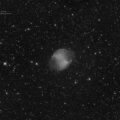It’s been already over one week since ASI290MM camera arrived to me directly from Shangai. It is a new ASI product, very low noise, 2.13Mpx back illuminated CMOS sensor mono camera https://astronomy-imaging-camera.com/products/usb-3-0/asi290mm/ .

In the box there is standard ASI equipment – camera, nosepiece, 2.1mm lens, ST4 cable and USB3.0 cable – more about USB cable later.
Camera IMX290 sensor is panoramic, 6.5mm diagonal, and pixel size is 2.9um. Despite its small size pixel has quite a lot of place for signal – full well depth is 14500e. Read noise is 3e with gain set to 0 and drops to 1e for gain 30dB. It gives pretty well dynamic range – 12EV for low gain and still over 8EV for 30dB gain.

Very low read noise comes together with high sensitivity. Absolute QE value is about 70%, but the camera is very sensitive in red and infrared range. Its sensitivity drops to half at 860nm – for example for ASI120MM it is 670nm.
Camera drivers installed without problems and at Toshiba Satellite L50 ASI290MM reached maximum full resolution speed 172fps / 8bit and 78fps / 16bit with SharpCap 2.8 and FireCapture 2.5.
At Lenovo T420s there was a problem with USB3.0 Renesas driver, so connected to USB3.0 port camera camera randomly hanged. After removing driver and installing Microsoft 0.96 driver version and replacing the USB3.0 cable camera works also at my Lenovo laptop.
Below a few recently made pictures with SCT8″ and TVx2:


Full version here https://astrojolo.com/wp-content/uploads/2016/05/2016-05-15-2015_3-IR_AS_p25_g4_ap377-caucasus.jpg


Camera has met my expectations – its very low noise, pretty sensitive in wide range up to 900nm, fast and has reasonable resolution 2.13Mpx, so it is possible to create lunar panoramas and picture quite a lot of Moon and Sun surface at once. It also helps to find a target 🙂
Comparing to my previous ASI gear – ASI120MM, new camera has obvious less noise and is more sensitive in IR – it is visible when imaging Moon with IR pass filter. Low noise and high dynamic range allows to extract subtle details when imaging Moon with 12 bit resolution, and for planets we can shorten exposure to freeze seeing or decrease gain to lower the noise.
Clear skies!

